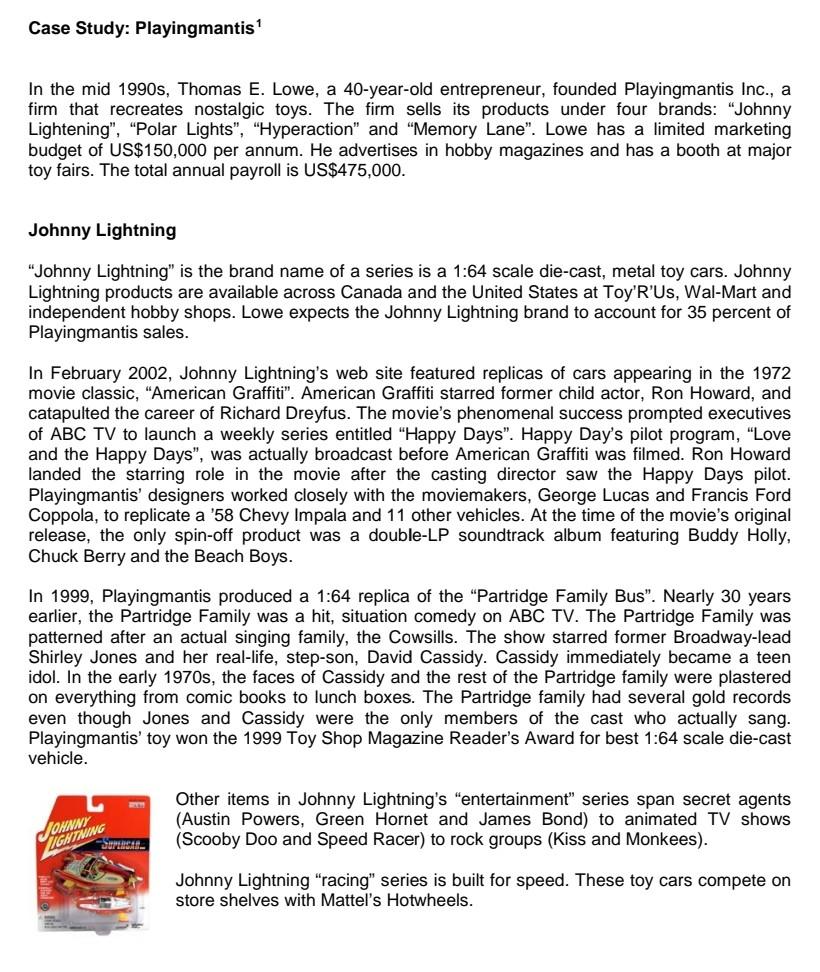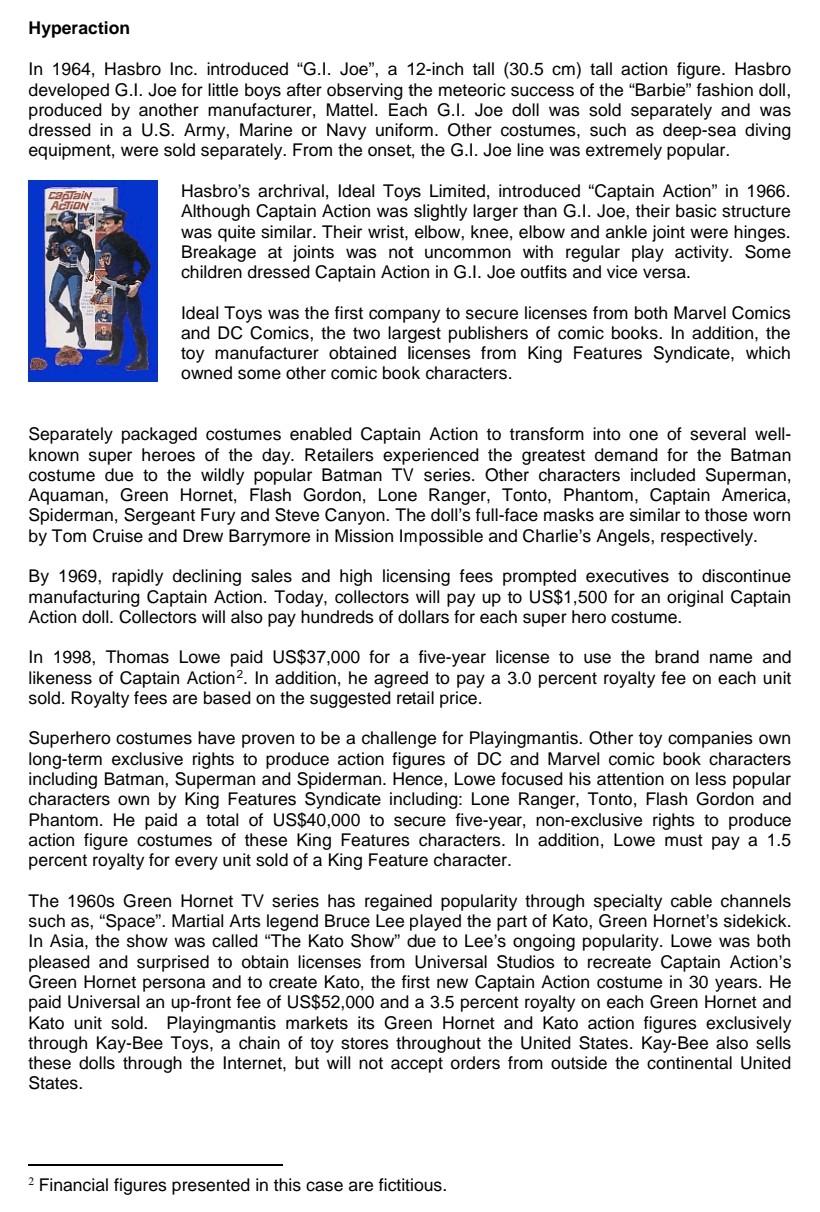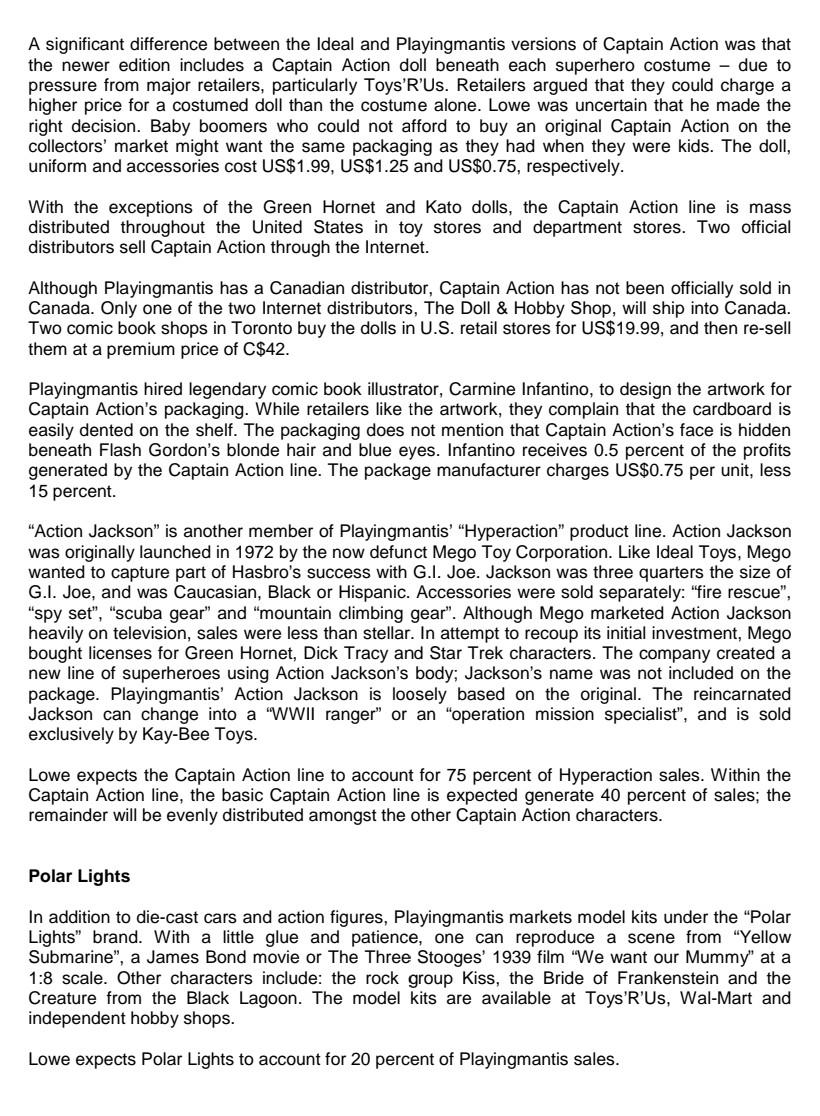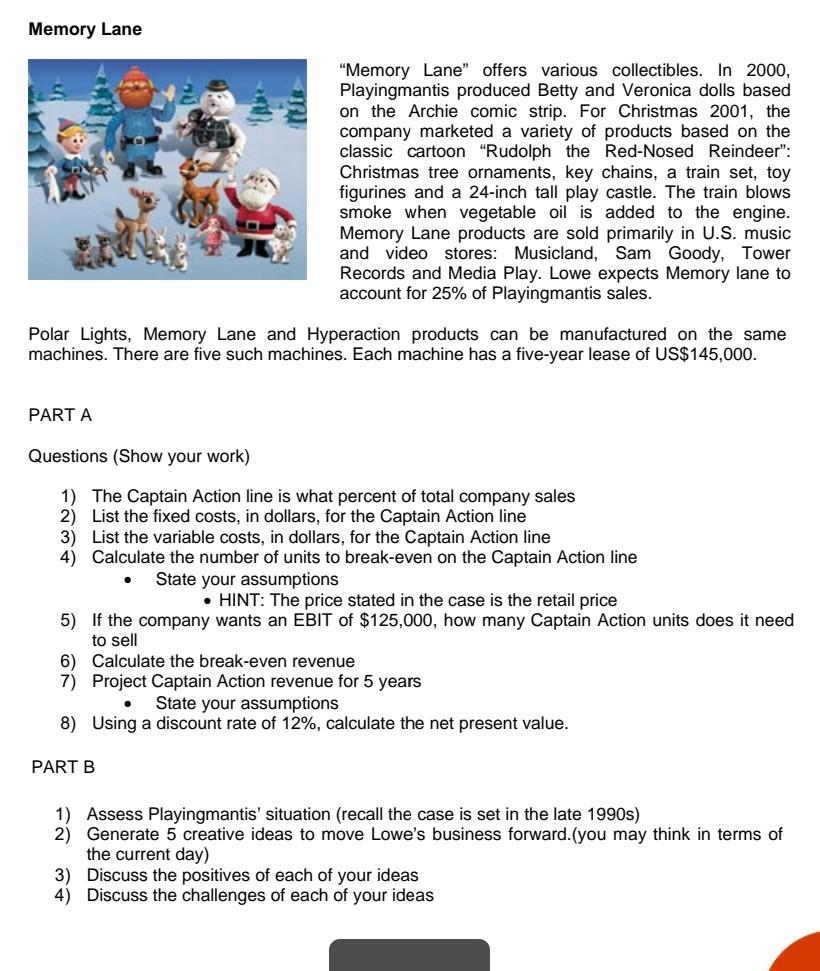



Case Study: Playingmantis 1 In the mid 1990s, Thomas E. Lowe, a 40-year-old entrepreneur, founded Playingmantis Inc., a firm that recreates nostalgic toys. The firm sells its products under four brands: "Johnny Lightening", "Polar Lights", "Hyperaction" and "Memory Lane". Lowe has a limited marketing budget of US\$150,000 per annum. He advertises in hobby magazines and has a booth at major toy fairs. The total annual payroll is US\$475,000. Johnny Lightning "Johnny Lightning" is the brand name of a series is a 1:64 scale die-cast, metal toy cars. Johnny Lightning products are available across Canada and the United States at Toy'R'Us, Wal-Mart and independent hobby shops. Lowe expects the Johnny Lightning brand to account for 35 percent of Playingmantis sales. In February 2002, Johnny Lightning's web site featured replicas of cars appearing in the 1972 movie classic, "American Graffiti". American Graffiti starred former child actor, Ron Howard, and catapulted the career of Richard Dreyfus. The movie's phenomenal success prompted executives of ABC TV to launch a weekly series entitled "Happy Days". Happy Day's pilot program, "Love and the Happy Days", was actually broadcast before American Graffiti was filmed. Ron Howard landed the starring role in the movie after the casting director saw the Happy Days pilot. Playingmantis' designers worked closely with the moviemakers, George Lucas and Francis Ford Coppola, to replicate a '58 Chevy Impala and 11 other vehicles. At the time of the movie's original release, the only spin-off product was a double-LP soundtrack album featuring Buddy Holly, Chuck Berry and the Beach Boys. In 1999, Playingmantis produced a 1:64 replica of the "Partridge Family Bus". Nearly 30 years earlier, the Partridge Family was a hit, situation comedy on ABC TV. The Partridge Family was patterned after an actual singing family, the Cowsills. The show starred former Broadway-lead Shirley Jones and her real-life, step-son, David Cassidy. Cassidy immediately became a teen idol. In the early 1970 s, the faces of Cassidy and the rest of the Partridge family were plastered on everything from comic books to lunch boxes. The Partridge family had several gold records even though Jones and Cassidy were the only members of the cast who actually sang. Playingmantis' toy won the 1999 Toy Shop Magazine Reader's Award for best 1:64 scale die-cast vehicle. Other items in Johnny Lightning's "entertainment" series span secret agents (Austin Powers, Green Hornet and James Bond) to animated TV shows (Scooby Doo and Speed Racer) to rock groups (Kiss and Monkees). Johnny Lightning "racing" series is built for speed. These toy cars compete on store shelves with Mattel's Hotwheels. Hyperaction In 1964, Hasbro Inc. introduced "G.I. Joe", a 12-inch tall (30.5cm) tall action figure. Hasbro developed G.I. Joe for little boys after observing the meteoric success of the "Barbie" fashion doll, produced by another manufacturer, Mattel. Each G.I. Joe doll was sold separately and was dressed in a U.S. Army, Marine or Navy uniform. Other costumes, such as deep-sea diving equipment, were sold separately. From the onset, the G.I. Joe line was extremely popular. Hasbro's archrival, Ideal Toys Limited, introduced "Captain Action" in 1966. Although Captain Action was slightly larger than G.I. Joe, their basic structure was quite similar. Their wrist, elbow, knee, elbow and ankle joint were hinges. Breakage at joints was not uncommon with regular play activity. Some children dressed Captain Action in G.I. Joe outfits and vice versa. Ideal Toys was the first company to secure licenses from both Marvel Comics and DC Comics, the two largest publishers of comic books. In addition, the toy manufacturer obtained licenses from King Features Syndicate, which owned some other comic book characters. Separately packaged costumes enabled Captain Action to transform into one of several wellknown super heroes of the day. Retailers experienced the greatest demand for the Batman costume due to the wildly popular Batman TV series. Other characters included Superman, Aquaman, Green Hornet, Flash Gordon, Lone Ranger, Tonto, Phantom, Captain America, Spiderman, Sergeant Fury and Steve Canyon. The doll's full-face masks are similar to those worn by Tom Cruise and Drew Barrymore in Mission Impossible and Charlie's Angels, respectively. By 1969 , rapidly declining sales and high licensing fees prompted executives to discontinue manufacturing Captain Action. Today, collectors will pay up to US\$1,500 for an original Captain Action doll. Collectors will also pay hundreds of dollars for each super hero costume. In 1998, Thomas Lowe paid US\$37,000 for a five-year license to use the brand name and likeness of Captain Action 2. In addition, he agreed to pay a 3.0 percent royalty fee on each unit sold. Royalty fees are based on the suggested retail price. Superhero costumes have proven to be a challenge for Playingmantis. Other toy companies own long-term exclusive rights to produce action figures of DC and Marvel comic book characters including Batman, Superman and Spiderman. Hence, Lowe focused his attention on less popular characters own by King Features Syndicate including: Lone Ranger, Tonto, Flash Gordon and Phantom. He paid a total of US\$40,000 to secure five-year, non-exclusive rights to produce action figure costumes of these King Features characters. In addition, Lowe must pay a 1.5 percent royalty for every unit sold of a King Feature character. The 1960 s Green Hornet TV series has regained popularity through specialty cable channels such as, "Space". Martial Arts legend Bruce Lee played the part of Kato, Green Hornet's sidekick. In Asia, the show was called "The Kato Show" due to Lee's ongoing popularity. Lowe was both pleased and surprised to obtain licenses from Universal Studios to recreate Captain Action's Green Hornet persona and to create Kato, the first new Captain Action costume in 30 years. He paid Universal an up-front fee of US\$52,000 and a 3.5 percent royalty on each Green Hornet and Kato unit sold. Playingmantis markets its Green Hornet and Kato action figures exclusively through Kay-Bee Toys, a chain of toy stores throughout the United States. Kay-Bee also sells these dolls through the Internet, but will not accept orders from outside the continental United States. A significant difference between the Ideal and Playingmantis versions of Captain Action was that the newer edition includes a Captain Action doll beneath each superhero costume - due to pressure from major retailers, particularly Toys'R'Us. Retailers argued that they could charge a higher price for a costumed doll than the costume alone. Lowe was uncertain that he made the right decision. Baby boomers who could not afford to buy an original Captain Action on the collectors' market might want the same packaging as they had when they were kids. The doll, uniform and accessories cost US\$1.99, US\$1.25 and US\$0.75, respectively. With the exceptions of the Green Hornet and Kato dolls, the Captain Action line is mass distributed throughout the United States in toy stores and department stores. Two official distributors sell Captain Action through the Internet. Although Playingmantis has a Canadian distributor, Captain Action has not been officially sold in Canada. Only one of the two Internet distributors, The Doll \& Hobby Shop, will ship into Canada. Two comic book shops in Toronto buy the dolls in U.S. retail stores for US\$19.99, and then re-sell them at a premium price of C$42. Playingmantis hired legendary comic book illustrator, Carmine Infantino, to design the artwork for Captain Action's packaging. While retailers like the artwork, they complain that the cardboard is easily dented on the shelf. The packaging does not mention that Captain Action's face is hidden beneath Flash Gordon's blonde hair and blue eyes. Infantino receives 0.5 percent of the profits generated by the Captain Action line. The package manufacturer charges US $0.75 per unit, less 15 percent. "Action Jackson" is another member of Playingmantis' "Hyperaction" product line. Action Jackson was originally launched in 1972 by the now defunct Mego Toy Corporation. Like Ideal Toys, Mego wanted to capture part of Hasbro's success with G.I. Joe. Jackson was three quarters the size of G.I. Joe, and was Caucasian, Black or Hispanic. Accessories were sold separately: "fire rescue", "spy set", "scuba gear" and "mountain climbing gear". Although Mego marketed Action Jackson heavily on television, sales were less than stellar. In attempt to recoup its initial investment, Mego bought licenses for Green Hornet, Dick Tracy and Star Trek characters. The company created a new line of superheroes using Action Jackson's body; Jackson's name was not included on the package. Playingmantis' Action Jackson is loosely based on the original. The reincarnated Jackson can change into a "WWII ranger" or an "operation mission specialist", and is sold exclusively by Kay-Bee Toys. Lowe expects the Captain Action line to account for 75 percent of Hyperaction sales. Within the Captain Action line, the basic Captain Action line is expected generate 40 percent of sales; the remainder will be evenly distributed amongst the other Captain Action characters. Polar Lights In addition to die-cast cars and action figures, Playingmantis markets model kits under the "Polar Lights" brand. With a little glue and patience, one can reproduce a scene from "Yellow Submarine", a James Bond movie or The Three Stooges' 1939 film "We want our Mummy" at a 1:8 scale. Other characters include: the rock group Kiss, the Bride of Frankenstein and the Creature from the Black Lagoon. The model kits are available at Toys'R'Us, Wal-Mart and independent hobby shops. Lowe expects Polar Lights to account for 20 percent of Playingmantis sales. Memory Lane "Memory Lane" offers various collectibles. In 2000, Playingmantis produced Betty and Veronica dolls based on the Archie comic strip. For Christmas 2001, the company marketed a variety of products based on the classic cartoon "Rudolph the Red-Nosed Reindeer": Christmas tree ornaments, key chains, a train set, toy figurines and a 24-inch tall play castle. The train blows smoke when vegetable oil is added to the engine. Memory Lane products are sold primarily in U.S. music and video stores: Musicland, Sam Goody, Tower Records and Media Play. Lowe expects Memory lane to account for 25% of Playingmantis sales. Polar Lights, Memory Lane and Hyperaction products can be manufactured on the same machines. There are five such machines. Each machine has a five-year lease of US\$145,000. PART A Questions (Show your work) 1) The Captain Action line is what percent of total company sales 2) List the fixed costs, in dollars, for the Captain Action line 3) List the variable costs, in dollars, for the Captain Action line 4) Calculate the number of units to break-even on the Captain Action line - State your assumptions - HINT: The price stated in the case is the retail price 5) If the company wants an EBIT of $125,000, how many Captain Action units does it need to sell 6) Calculate the break-even revenue 7) Project Captain Action revenue for 5 years - State your assumptions 8) Using a discount rate of 12%, calculate the net present value. PART B 1) Assess Playingmantis' situation (recall the case is set in the late 1990s) 2) Generate 5 creative ideas to move Lowe's business forward.(you may think in terms of the current day) 3) Discuss the positives of each of your ideas 4) Discuss the challenges of each of your ideas Case Study: Playingmantis 1 In the mid 1990s, Thomas E. Lowe, a 40-year-old entrepreneur, founded Playingmantis Inc., a firm that recreates nostalgic toys. The firm sells its products under four brands: "Johnny Lightening", "Polar Lights", "Hyperaction" and "Memory Lane". Lowe has a limited marketing budget of US\$150,000 per annum. He advertises in hobby magazines and has a booth at major toy fairs. The total annual payroll is US\$475,000. Johnny Lightning "Johnny Lightning" is the brand name of a series is a 1:64 scale die-cast, metal toy cars. Johnny Lightning products are available across Canada and the United States at Toy'R'Us, Wal-Mart and independent hobby shops. Lowe expects the Johnny Lightning brand to account for 35 percent of Playingmantis sales. In February 2002, Johnny Lightning's web site featured replicas of cars appearing in the 1972 movie classic, "American Graffiti". American Graffiti starred former child actor, Ron Howard, and catapulted the career of Richard Dreyfus. The movie's phenomenal success prompted executives of ABC TV to launch a weekly series entitled "Happy Days". Happy Day's pilot program, "Love and the Happy Days", was actually broadcast before American Graffiti was filmed. Ron Howard landed the starring role in the movie after the casting director saw the Happy Days pilot. Playingmantis' designers worked closely with the moviemakers, George Lucas and Francis Ford Coppola, to replicate a '58 Chevy Impala and 11 other vehicles. At the time of the movie's original release, the only spin-off product was a double-LP soundtrack album featuring Buddy Holly, Chuck Berry and the Beach Boys. In 1999, Playingmantis produced a 1:64 replica of the "Partridge Family Bus". Nearly 30 years earlier, the Partridge Family was a hit, situation comedy on ABC TV. The Partridge Family was patterned after an actual singing family, the Cowsills. The show starred former Broadway-lead Shirley Jones and her real-life, step-son, David Cassidy. Cassidy immediately became a teen idol. In the early 1970 s, the faces of Cassidy and the rest of the Partridge family were plastered on everything from comic books to lunch boxes. The Partridge family had several gold records even though Jones and Cassidy were the only members of the cast who actually sang. Playingmantis' toy won the 1999 Toy Shop Magazine Reader's Award for best 1:64 scale die-cast vehicle. Other items in Johnny Lightning's "entertainment" series span secret agents (Austin Powers, Green Hornet and James Bond) to animated TV shows (Scooby Doo and Speed Racer) to rock groups (Kiss and Monkees). Johnny Lightning "racing" series is built for speed. These toy cars compete on store shelves with Mattel's Hotwheels. Hyperaction In 1964, Hasbro Inc. introduced "G.I. Joe", a 12-inch tall (30.5cm) tall action figure. Hasbro developed G.I. Joe for little boys after observing the meteoric success of the "Barbie" fashion doll, produced by another manufacturer, Mattel. Each G.I. Joe doll was sold separately and was dressed in a U.S. Army, Marine or Navy uniform. Other costumes, such as deep-sea diving equipment, were sold separately. From the onset, the G.I. Joe line was extremely popular. Hasbro's archrival, Ideal Toys Limited, introduced "Captain Action" in 1966. Although Captain Action was slightly larger than G.I. Joe, their basic structure was quite similar. Their wrist, elbow, knee, elbow and ankle joint were hinges. Breakage at joints was not uncommon with regular play activity. Some children dressed Captain Action in G.I. Joe outfits and vice versa. Ideal Toys was the first company to secure licenses from both Marvel Comics and DC Comics, the two largest publishers of comic books. In addition, the toy manufacturer obtained licenses from King Features Syndicate, which owned some other comic book characters. Separately packaged costumes enabled Captain Action to transform into one of several wellknown super heroes of the day. Retailers experienced the greatest demand for the Batman costume due to the wildly popular Batman TV series. Other characters included Superman, Aquaman, Green Hornet, Flash Gordon, Lone Ranger, Tonto, Phantom, Captain America, Spiderman, Sergeant Fury and Steve Canyon. The doll's full-face masks are similar to those worn by Tom Cruise and Drew Barrymore in Mission Impossible and Charlie's Angels, respectively. By 1969 , rapidly declining sales and high licensing fees prompted executives to discontinue manufacturing Captain Action. Today, collectors will pay up to US\$1,500 for an original Captain Action doll. Collectors will also pay hundreds of dollars for each super hero costume. In 1998, Thomas Lowe paid US\$37,000 for a five-year license to use the brand name and likeness of Captain Action 2. In addition, he agreed to pay a 3.0 percent royalty fee on each unit sold. Royalty fees are based on the suggested retail price. Superhero costumes have proven to be a challenge for Playingmantis. Other toy companies own long-term exclusive rights to produce action figures of DC and Marvel comic book characters including Batman, Superman and Spiderman. Hence, Lowe focused his attention on less popular characters own by King Features Syndicate including: Lone Ranger, Tonto, Flash Gordon and Phantom. He paid a total of US\$40,000 to secure five-year, non-exclusive rights to produce action figure costumes of these King Features characters. In addition, Lowe must pay a 1.5 percent royalty for every unit sold of a King Feature character. The 1960 s Green Hornet TV series has regained popularity through specialty cable channels such as, "Space". Martial Arts legend Bruce Lee played the part of Kato, Green Hornet's sidekick. In Asia, the show was called "The Kato Show" due to Lee's ongoing popularity. Lowe was both pleased and surprised to obtain licenses from Universal Studios to recreate Captain Action's Green Hornet persona and to create Kato, the first new Captain Action costume in 30 years. He paid Universal an up-front fee of US\$52,000 and a 3.5 percent royalty on each Green Hornet and Kato unit sold. Playingmantis markets its Green Hornet and Kato action figures exclusively through Kay-Bee Toys, a chain of toy stores throughout the United States. Kay-Bee also sells these dolls through the Internet, but will not accept orders from outside the continental United States. A significant difference between the Ideal and Playingmantis versions of Captain Action was that the newer edition includes a Captain Action doll beneath each superhero costume - due to pressure from major retailers, particularly Toys'R'Us. Retailers argued that they could charge a higher price for a costumed doll than the costume alone. Lowe was uncertain that he made the right decision. Baby boomers who could not afford to buy an original Captain Action on the collectors' market might want the same packaging as they had when they were kids. The doll, uniform and accessories cost US\$1.99, US\$1.25 and US\$0.75, respectively. With the exceptions of the Green Hornet and Kato dolls, the Captain Action line is mass distributed throughout the United States in toy stores and department stores. Two official distributors sell Captain Action through the Internet. Although Playingmantis has a Canadian distributor, Captain Action has not been officially sold in Canada. Only one of the two Internet distributors, The Doll \& Hobby Shop, will ship into Canada. Two comic book shops in Toronto buy the dolls in U.S. retail stores for US\$19.99, and then re-sell them at a premium price of C$42. Playingmantis hired legendary comic book illustrator, Carmine Infantino, to design the artwork for Captain Action's packaging. While retailers like the artwork, they complain that the cardboard is easily dented on the shelf. The packaging does not mention that Captain Action's face is hidden beneath Flash Gordon's blonde hair and blue eyes. Infantino receives 0.5 percent of the profits generated by the Captain Action line. The package manufacturer charges US $0.75 per unit, less 15 percent. "Action Jackson" is another member of Playingmantis' "Hyperaction" product line. Action Jackson was originally launched in 1972 by the now defunct Mego Toy Corporation. Like Ideal Toys, Mego wanted to capture part of Hasbro's success with G.I. Joe. Jackson was three quarters the size of G.I. Joe, and was Caucasian, Black or Hispanic. Accessories were sold separately: "fire rescue", "spy set", "scuba gear" and "mountain climbing gear". Although Mego marketed Action Jackson heavily on television, sales were less than stellar. In attempt to recoup its initial investment, Mego bought licenses for Green Hornet, Dick Tracy and Star Trek characters. The company created a new line of superheroes using Action Jackson's body; Jackson's name was not included on the package. Playingmantis' Action Jackson is loosely based on the original. The reincarnated Jackson can change into a "WWII ranger" or an "operation mission specialist", and is sold exclusively by Kay-Bee Toys. Lowe expects the Captain Action line to account for 75 percent of Hyperaction sales. Within the Captain Action line, the basic Captain Action line is expected generate 40 percent of sales; the remainder will be evenly distributed amongst the other Captain Action characters. Polar Lights In addition to die-cast cars and action figures, Playingmantis markets model kits under the "Polar Lights" brand. With a little glue and patience, one can reproduce a scene from "Yellow Submarine", a James Bond movie or The Three Stooges' 1939 film "We want our Mummy" at a 1:8 scale. Other characters include: the rock group Kiss, the Bride of Frankenstein and the Creature from the Black Lagoon. The model kits are available at Toys'R'Us, Wal-Mart and independent hobby shops. Lowe expects Polar Lights to account for 20 percent of Playingmantis sales. Memory Lane "Memory Lane" offers various collectibles. In 2000, Playingmantis produced Betty and Veronica dolls based on the Archie comic strip. For Christmas 2001, the company marketed a variety of products based on the classic cartoon "Rudolph the Red-Nosed Reindeer": Christmas tree ornaments, key chains, a train set, toy figurines and a 24-inch tall play castle. The train blows smoke when vegetable oil is added to the engine. Memory Lane products are sold primarily in U.S. music and video stores: Musicland, Sam Goody, Tower Records and Media Play. Lowe expects Memory lane to account for 25% of Playingmantis sales. Polar Lights, Memory Lane and Hyperaction products can be manufactured on the same machines. There are five such machines. Each machine has a five-year lease of US\$145,000. PART A Questions (Show your work) 1) The Captain Action line is what percent of total company sales 2) List the fixed costs, in dollars, for the Captain Action line 3) List the variable costs, in dollars, for the Captain Action line 4) Calculate the number of units to break-even on the Captain Action line - State your assumptions - HINT: The price stated in the case is the retail price 5) If the company wants an EBIT of $125,000, how many Captain Action units does it need to sell 6) Calculate the break-even revenue 7) Project Captain Action revenue for 5 years - State your assumptions 8) Using a discount rate of 12%, calculate the net present value. PART B 1) Assess Playingmantis' situation (recall the case is set in the late 1990s) 2) Generate 5 creative ideas to move Lowe's business forward.(you may think in terms of the current day) 3) Discuss the positives of each of your ideas 4) Discuss the challenges of each of your ideas










